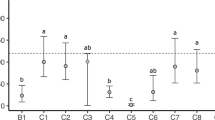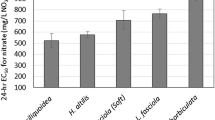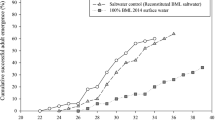Abstract
Oil and gas extraction in the Prairie Pothole Region (PPR) of the northern USA has resulted in elevated chloride concentrations in ground and surface water due to widespread contamination with highly saline produced water, or brine. The toxicity of chloride is poorly understood in the high hardness waters characteristic of the region. We evaluated the toxicity of chloride to two endemic species, Daphnia magna (water flea) and Lemna gibba (duckweed), exposed in field-collected waters (hardness ~ 3000 mg/L as CaCO3) and reconstituted waters (hardness 370 mg/L as CaCO3) intended to mimic PPR background waters. We also investigated the role of chloride in the toxicity of water reconstituted to mimic legacy brine-contaminated wetlands, using two populations of native Pseudacris maculata (Boreal Chorus Frog). Chloride toxicity was similar in field-collected and reconstituted waters for both D. magna (LC50s 3070–3788 mg Cl−1/L) and L. gibba (IC50s 2441–2887). Although hardness can ameliorate chloride toxicity at low to high hardness, we did not observe additional protection as hardness increased from 370 to ~ 3000 mg/L. In P. maculata exposures, chloride did not fully explain toxicity. Chloride sensitivity also differed between populations, with mortality at 2000 mg Cl−/L in one population but not the other, and population-specific growth responses. Overall, these results (1) document toxicity to native species at chloride concentrations occurring in the PPR, (2) indicate that very high hardness in the region’s waters may not provide additional protection against chloride and (3) highlight challenges of brine investigations, including whether surrogate study populations are representative of local populations.

source locations for the P. maculata populations. FWS = U.S. Fish and Wildlife Service


source population near Moran, Teton County, Wyoming. MO indicates tadpoles came from a source population in Sullivan County, Missouri

Similar content being viewed by others
References
Albecker MA, McCoy MW (2017) Adaptive responses to salinity stress across multiple life stages in anuran amphibians. Front Zool 14:40. https://doi.org/10.1186/s12983-017-0222-0
ASTM International (2004) Standard guide for conducting static toxicity tests with Lemna gibba (ASTM E1415–91 Reapproved 2004). ASTM Int, West Conshohocken, PA
ASTM International (2014) Standard guide for conducting acute toxicity tests on test materials with fishes, macroinvertebrates, and amphibians. (ASTM E729 – 96). ASTM Int., West Conshohocken, PA.
Balas CJ, Euliss NH Jr, Mushet DM (2012) Influence of conservation programs on amphibians using seasonal wetlands in the prairie pothole region. Wetl 32:333–345. https://doi.org/10.1007/s13157-012-0269-9
Bradley PW, Gervasi SS, Hua J, Cothran RD, Relyea RA, Olson DH, Blaustein AR (2015) Differences in sensitivity to the fungal pathogen Batrachochytrium dendrobatidis among amphibian populations. Conserv Biol 29:1347–1356. https://doi.org/10.1111/cobi.12566
Brady SP (2013) Microgeographic maladaptive performance and deme depression in a fragmented landscape. PeerJ 1:e163. https://doi.org/10.7717/peerj.163
Bridges CM, Semlitsch RD (2000) Variation in pesticide tolerance of tadpoles among and within species of Ranidae and patterns of amphibian decline. Conserv Biol 14:1490–1499. https://doi.org/10.1046/j.1523-1739.2000.99343.x
Buchholz DR, Hayes TB (2000) Larval period comparison for the spadefoot toads Scaphiopus couchii and Spea multiplicata (Pelobatidae:Anura). Herpetol 56:455–468
Clark CE, Veil JA (2009) Produced water volumes and management practices in the United States. Report No: ANL/EVS/R-09-1, Argonne Nat Lab, Argonne, Illinois 1–64. https://doi.org/10.2172/1007397
Cozzarelli IM, Skalak KJ, Kent DB, Engle MA, Benthem A, Mumford AC, Haase K, Farag A, Harper D, Nagel SC, Iwanowicz LR, Orem WH, Akob DM, Jaeschke JB, Galloway Kohler JM, Stoliker JL, Jolly GD (2017) Environmental signatures and effects of an oil and gas wastewater spill in the williston basin North Dakota. Sci Total Environ 579:1781–1793. https://doi.org/10.1016/j.scitotenv.2016.11.157
Eaton AD, Clesceri LS, Rice EW, Greenberg AE (2005) Standard methods for the examination of water and wastewater, 21st ed. American public health association water environment federation american water works association, Washington D.C, p 1,368
Eddy FB (1975) The effect of calcium on gill potentials and on sodium and chloride fluxes in the goldfish Carassius auratus. J Comp Physiol B 96:131–142. https://doi.org/10.1007/BF00706593
Elphick JRF, Bergh KD, Bailey HC (2011) Chronic toxicity of chloride to freshwater species: effects of hardness and implications for water quality guidelines. Environ Toxicol Chem 30:239–246. https://doi.org/10.1002/etc.365
Farag AM, Harper DD, Skaar D (2014) In situ and laboratory toxicity of coalbed natural produced waters with elevated sodium bicarbonate. Environ Toxicol Chem 33:2086–2093. https://doi.org/10.1002/etc.2658
Gillis PL (2011) Assessing the toxicity of sodium chloride to the glochidia of freshwater mussels: implications for salinization of surface waters. Environ Pollut 159:1702–1708. https://doi.org/10.1016/j.envpol.2011.02.032
Gleason RA, Tangen BA eds. (2014) Brine Contamination to aquatic resources from oil and gas development in the Williston Basin, United States. U.S. Geological survey scientific investigations report 2014–5017, U.S. Geological Survey, Reston, Virginia. https://doi.org/10.3133/sir20145017
Goldhaber MB, Mills CT, Morrison JM, Stricker CA, Mushet DM, LaBaugh JW (2014) Hydrogeochemistry of prairie pothole region wetlands: role of long-term critical zone processes. Chem Geol 387:170–183. https://doi.org/10.1016/j.chemgeo.2014.08.023
Gosner P (1960) A simplified table for staging anuran embryos and larvae with notes on identification. Herpetol 16:183–190
Hossack BR, Puglis HJ, Battaglin WA, Anderson CW, Honeycutt RK, Smalling KL (2017) Widespread legacy brine contamination from oil production reduces of chorus frog larvae. Environ Pollut 231:742–751. https://doi.org/10.1016/j.envpol.2017.08.070
Hossack BR, Smalling K, Anderson CW, Preston TM, Cozzarelli IM, Honeycutt K (2018) Effects of persistent energy-related brine contamination on amphibian abundance in national wildlife refuge wetlands. Biol Conserv 228:36–43. https://doi.org/10.1016/j.biocon.2018.10.007
Janke AK, Anteau MJ, Stafford JD (2017) Long-term spatial heterogeneity in mallard distribution in the Prairie Pothole Region. Wildl Soc Bull 41:116–124. https://doi.org/10.1002/wsb.747
Kondash AJ, Lauer NE, Vengosh A (2018) The intensification of the water footprint of hydraulic fracturing. Sci Adv 4:1–8. https://doi.org/10.1126/sciadv.aar5982
Lasier PJ, Winger PV, Harden IR (2006) Effects of hardness and alkalinity in culture and test waters on reproduction of Ceriodaphnia dubia. Environ Toxicol Chem 25:2781–2786. https://doi.org/10.1897/05-547R.1
Lauer NE, Harkness JS, Vengosh A (2016) Brine spills associated with unconventional oil development in North Dakota. Environ Sci Technol 50(5389):5397. https://doi.org/10.1021/acs.est.5b06349
Maloney KO, Baruch-Mordo S, Patterson LA, Nicot JP, Entrekin SA, Fargione JE, Kiesecker JM, Konschnik KE, Ryan JN, Trainor AM, Saiers JE (2017) Unconventional oil and gas spills: materials, volumes, and risks to surface waters in four states of the U.S. Sci Total Environ 581–582:369–377. https://doi.org/10.1016/j.scitotenv.2016.12.142
McShane RR, Barnhart TB, Valder JF, Haines SS, Macek-Rowland KM, Carter JM, Delzer GC, Thamke JN (2020) Estimates of water use associated with continuous oil and gas development in the Williston Basin, North Dakota and Montana, 2007–17: U.S. Geological survey scientific investigations report 2020–5012 https://doi.org/10.3133/sir20205012
Mount DR, Gulley DD, Hockett JR, Garrison T, Evans JM (1997) Statistical models to predict the toxicity of major ions to Ceriodaphnia dubia, Daphnia magna and Pimephales promelas (fathead minnows). Environ Toxicol Chem 16:2009–2019. https://doi.org/10.1002/etc.5620161005
Mount DR, Erickson RJ, Highland TL, Wisniewski S (2016) The acute toxicity of major ion salts to Ceriodaphnia dubia: I. influence of background water chemistry. Environ Toxicol Chem 35:3039–3057. https://doi.org/10.1002/etc.3487
Padhye AD, Ghate HV (1992) Sodium chloride and potassium chloride tolerance of different stages of the frog, Microhyla ornata. Herp Jour 2:18–23
Peterman ZE Thamke, JN, Futa K Oliver TA (2010) Strontium isotope detection of brine contamination in the East Poplar oil field, Montana: U.S. Geological survey open-file report 2010–1326. https://doi.org/10.3133/ofr20101326
Post van der Burg M, Tangen B (2014) Monitoring and modeling wetland chloride concentrations in relationship to oil and gas development. Environ Manage 150:120–127. https://doi.org/10.1016/j.jenvman.2014.10.028
Potts WT, Fleming WR (1970) The effects of prolactin and divalent ions on the permeability to water of Fundulus kansae. J Exp Biol 53:317–327. https://doi.org/10.1242/jeb.53.2.317
Preston TM, Ray AM (2017) Effects of energy development on wetland plants and macroinvertebrate communities in Prairie Pothole Region. Freshw Ecol 32:29–34. https://doi.org/10.1080/02705060.2016.1231137
Preston TM, Chesley-Preston T, Thamke JN (2014) A GIS-based vulnerability assessment of brine contamination to aquatic resources from oil and gas development in eastern Sheridan County, Montana. Sci Total Environ 472:1152–1162. https://doi.org/10.1016/j.scitotenv.2013.09.027
Preston TM, Borgreen MJ, Ray AM (2018) Effects of brine contamination from energy development on wetland macroinvertebrate community structure in the Prairie Pothole Region. Environ Poll 239:722–732. https://doi.org/10.1016/j.envpol.2018.04.088
Preston TM, Anderson CW, Thamke JM, Hossack BR, Skalak KJ, Cozzarelli IM (2019) Predicting attenuation of salinized surface- and groundwater-resources from legacy energy development in the Prairie Pothole Region. Sci Total Environ 690:522–533. https://doi.org/10.1016/j.scitotenv.2019.06.428
Preston TM, Smith BD, Thamke JN, Chesley-Preston T (2012) Water-quality and geophysical data for three study sites within the Williston Basin and Prairie Pothole Region: U.S. Geological survey open-file report 2012–1149, 17 p https://doi.org/10.3133/ofr20121149
Puglis HJ, Kunz BK, Harper DD, Farag AM (2022) Biological and chemical data from chloride bioassays with native wetland species in natural and reconstituted Prairie Pothole waters. U.S. Geological Survey data release. https://doi.org/10.5066/P9BQ6YRZ
Reiten JC, Tischmak T (1993) Appraisal of oil field brine contamination in shallow ground water and surface water eastern Sheridan County Montana. Mont Bur Min Geol Open-File Report 260:300
Rouse DR, Nelson KJ, Reiten JC (2013) Montana-impacts of oil exploration and production to the northeast Montana Wetland management district. Mont Bur Min Geol Open-File Report 620:624
SAS Institute Inc (2016) Version 9.4, SAS Institute Inc, Cary, NC, USA
Shrestha N, Chilkoor G, Wilder J, Gadhamshetty V, Stone JJ (2017) Potential water resource impacts of hydraulic fracturing from unconventional oil production in the Bakken shale. Water Res 108:1–24. https://doi.org/10.1016/j.watres.2016.11.006
Smalling KL, Anderson CW, Honeycutt RK, Cozzarelli IM, Preston T, Hossack BR (2019) Associations between environmental pollutants and larval amphibians in wetlands contaminated by energy-related brines are potentially mediated by feeding traits. Environ Poll 248:260–268. https://doi.org/10.1016/j.envpol.2019.02.033
Soucek DR (2007) Comparison of hardness- and chloride-regulated acute effects of sodium sulfate on two freshwater crustaceans. Environ Toxicol Chem 26:773–779. https://doi.org/10.1897/06-229R.1
Soucek DR, Linton T, Tarr CD, Dickinson A (2011) Influence of water hardness and sulfate on the acute toxicity of chloride to sensitive freshwater invertebrates. Environ Toxicol Chem 30:930–938. https://doi.org/10.1002/etc.454
Soucek DR, Mount DR, Dickinson A, Hockett JR (2018) Influence of dilution water ionic composition on acute major ion toxicity to the Mayfly Neocloeon triangulifer. Environ Toxicol 37:1330–1339. https://doi.org/10.1002/etc.4072
Tornabene BJ, Breuner CW, Hossack BR (2020) Relative toxicity and sublethal effects of NaCl and energy-related saline wastewaters on prairie amphibians. Aquat Toxicol 228:105626. https://doi.org/10.1016/j.aquatox.2020.105626
USEPA (1993) Method 300.0: Determination of inorganic anions by ion chromatography. revision 2.1. Cincinnati, OH. Method 300.0 Determination of inorganic anions by ion chromatography, Rev. 2.1 (epa.gov)
USEPA (1994) Method 200.7: Determination of metals and trace elements in water and wastes by inductively coupled plasma-atomic emission spectrometry. revision 4.4. Cincinnati, OH. Method 200.7, Rev. 4.4 (epa.gov)
USEPA (2002) Methods for measuring the acute toxicity of effluents and receiving waters to freshwater and marine organisms, 5th ed. U.S. environmental protection agency, Office of Water (4303T), EPA 821/R-02/012. Washington, DC. viii-266. https://www.epa.gov/sites/production/files/2015-08/documents/acute-freshwater-and-marine-wet-manual_2002.pdf
USEPA (2007) Method 9056A: Determination of inorganic anions by ion chromatography. SW-846 Online—Test methods for evaluating solid waste, physical/chemical methods. Washington, D.C.:U.S. Environmental protection agency. https://www.epa.gov/sites/default/files/2015-12/documents/9056a.pdf
USEPA (2014) Method 6020B: Inductively coupled plasma-mass spectrometry, revision 2. SW-846 Online—Test methods for evaluating solid waste, physical/chemical methods. Washington, D.C.:U.S. Environmental protection agency. https://www.epa.gov/sites/default/files/2015-12/documents/6020b.pdf
Veil JA, Puder MG, Elcock D, Redweik RJ Jr (2004) A white paper describing produced water from production of crude oil, natural gas, and coal bed methane: prepared for the U.S. Department of Energy, National energy technology laboratory. Argonne National Laboratory, Argonne, Ill 79
Wang N, Ivey CD, Dorman RA, Ingersoll CG, Steevens J, Hammer EJ, Bauer CR, Mount DR (2018) Acute toxicity of sodium chloride and potassium chloride to a unionid mussel (Lampsilis siliquoidea) in water exposures. Environ Toxicol Chem 37:3041–3049. https://doi.org/10.1002/etc.4206
Wang N, Kunz JL, Cleveland D, Steevens JA, Cozzarelli IM (2019) Biological effects of elevated major ions in surface water contaminated by a produced water from oil production. Arch Environ Cont Toxicol 76:670–677. https://doi.org/10.1007/s00244-019-00610-3
Acknowledgements
The co-authors would like to thank two anonymous reviewers for their thoughtful comments that improved this manuscript. We would also like to acknowledge Todd Preston for assistance in creating a figure for this paper as well as providing a critical review of the manuscript. For assistance with data collection, we would like to thank Erinn Scott, Samantha Tidwell, Taylor Tidwell, Christina Mackey, Danielle Cleveland and the CERC Inorganic Chemistry Team, Callahan Jobe, and Paige Anderson. We would also like to thank Blake Hossack and Leah Swartz for Wyoming amphibian embryo collection. Any use of trade, firm, or product names is for descriptive purposes only and does not imply endorsement by the U.S. Government.
Funding
Funding was provided by the USGS Environmental Health Program.
Author information
Authors and Affiliations
Corresponding author
Ethics declarations
Conflict of interest
Authors have no conflicts of interest.
Human and Animal Rights
All research was conducted following USGS Columbia Environmental Research Center Animal Care and Use Committee guidelines. Research with Pseudacris maculata was approved under IACUC No.:18–020.
Supplementary Information
Below is the link to the electronic supplementary material.
Rights and permissions
About this article
Cite this article
Harper, D.D., Puglis, H.J., Kunz, B.K. et al. Chloride Toxicity to Native Freshwater Species in Natural and Reconstituted Prairie Pothole Waters. Arch Environ Contam Toxicol 82, 416–428 (2022). https://doi.org/10.1007/s00244-022-00927-6
Received:
Accepted:
Published:
Issue Date:
DOI: https://doi.org/10.1007/s00244-022-00927-6




